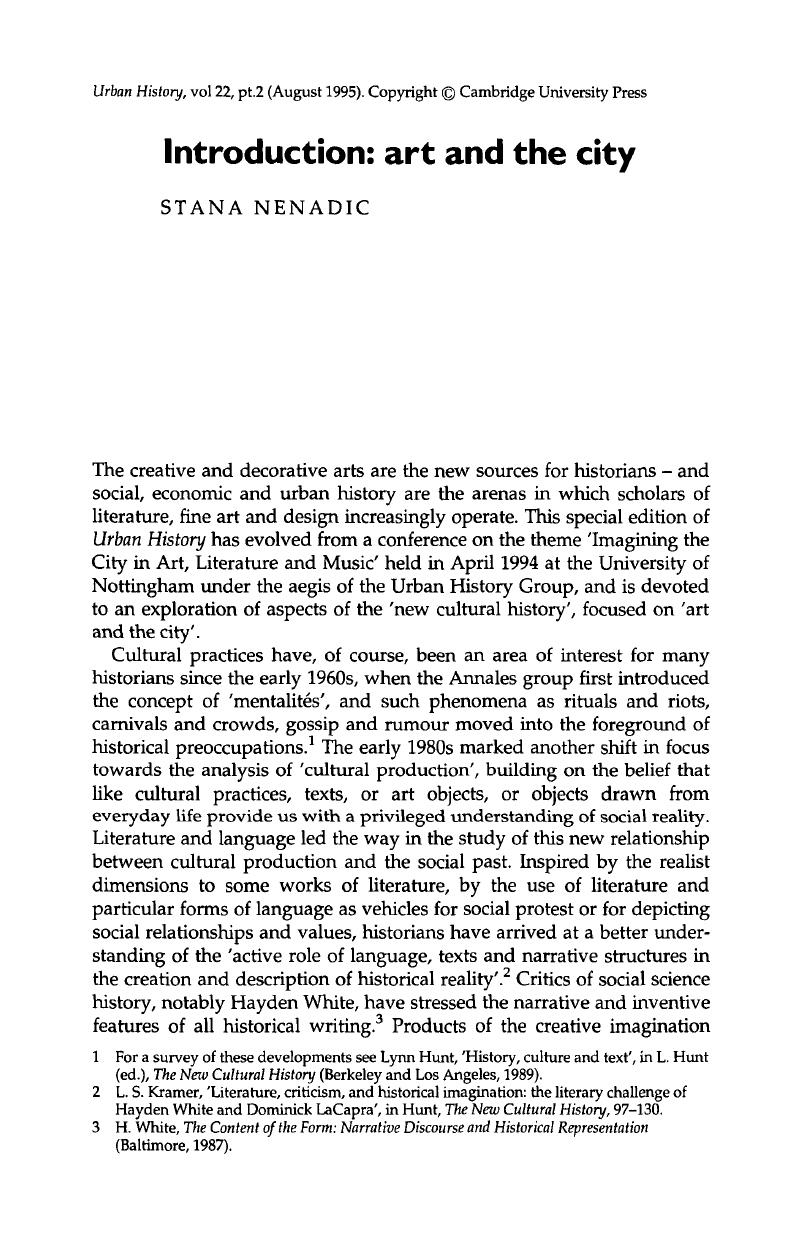No CrossRef data available.
Article contents
Introduction: art and the city
Published online by Cambridge University Press: 09 February 2009
Abstract

- Type
- Introduction
- Information
- Copyright
- Copyright © Cambridge University Press 1995
References
1 For a survey of these developments see Hunt, Lynn, ‘History, culture and text’, in Hunt, L. (ed.), The New Cultural History (Berkeley and Los Angeles, 1989).CrossRefGoogle Scholar
2 Kramer, L. S., ‘Literature, criticism, and historical imagination: the literary challenge of Hayden White and Dominick LaCapra’Google Scholar, in Hunt, , The New Cultural History, 97–130.Google Scholar
3 White, H., The Content of the Form: Narrative Discourse and Historical Representation (Baltimore, 1987).Google Scholar
4 On literature and history, and some of the problems in reconciling the two disciplines, see Kelly, J. and Kelly, T., ‘Social history update: searching the dark alley: new historicism and social history’, Journal of Social History, 25 (3) (1992), 677–94.CrossRefGoogle Scholar
5 Quoted in Nenadic, S., ‘Illegitimacy, insanity and insolvency: Wilkie Collins and the Victorian nightmares’, in Marwick, A. (ed.), The Arts, Literature and Society (London, 1990).Google Scholar
6 Davis, N. Zemon, Fiction in the Archives: Pardon Tales and their Telling in Sixteen-Century France (Stanford, 1987).Google Scholar
7 Pointon, M., The Body Imaged: the Human Form and Visual Culture since the Renaissance (Cambridge, 1993).Google Scholar
8 Pointon, M., Hanging the Head: Portraiture and Social Formation in Eighteenth-Century England (New Haven and London, 1993).Google Scholar
9 See, for example, Roche, D., The Culture of Clothing: Dress and Fashion in the Ancient Regime (Cambridge, 1994).Google Scholar
10 Wolff, J. and Seed, J. (eds), The Culture of Capital: Art, Power and the Nineteenth-Century Middle Class (Manchester, 1988).Google Scholar
11 Anderson, P., The Printed Image and the Transformation of Popular Culture, 1790–1860 (Oxford, 1991).Google Scholar
12 Brewer, J. and Porter, R. (eds), Consumption and the World of Goods, 2 vols (London, 1993).Google Scholar
13 Carson, C., ‘City museums as history’, Journal of Urban History, 18, 2 (1992), 183–91.CrossRefGoogle Scholar
14 See, for example, Stedman-Jones, G., The Languages of Class: Studies in English Working Class History 1832–1982 (Cambridge, 1983).Google Scholar
15 This diversity is addressed in Hunt, The New Cultural History.
16 A good illustration is provided by Solkin, D. H., Painting for Money, the Visual Arts and the Public Sphere in Eighteenth-Century England (New Haven, 1992).Google Scholar
17 See Alessio, D. T., ‘Capitalist realist art: industrial images of Hamilton, Ontario, 1884–1910’, Journal of Urban History, 18, 4 (1992), 442–69.CrossRefGoogle Scholar
18 Sennet, R., The Conscience of the Eye: the Design and Social Life of Cities (New York, 1991).Google Scholar
19 Described, for example, in Seed, J., ‘Commerce and the liberal arts: the political economy of art in Manchester, 1775–1860’Google Scholar, in Wolff, and Seed, , The Culture of Capital.Google Scholar
20 Examined so convincingly by Schama, S., The Embarrassment of Riches: an Interpretation of Dutch Culture in the Golden Age (London, 1985).Google Scholar
21 See the many works that are cited by Gee and Steward in their account of art and the central European city, contained in this edition of Urban History.




